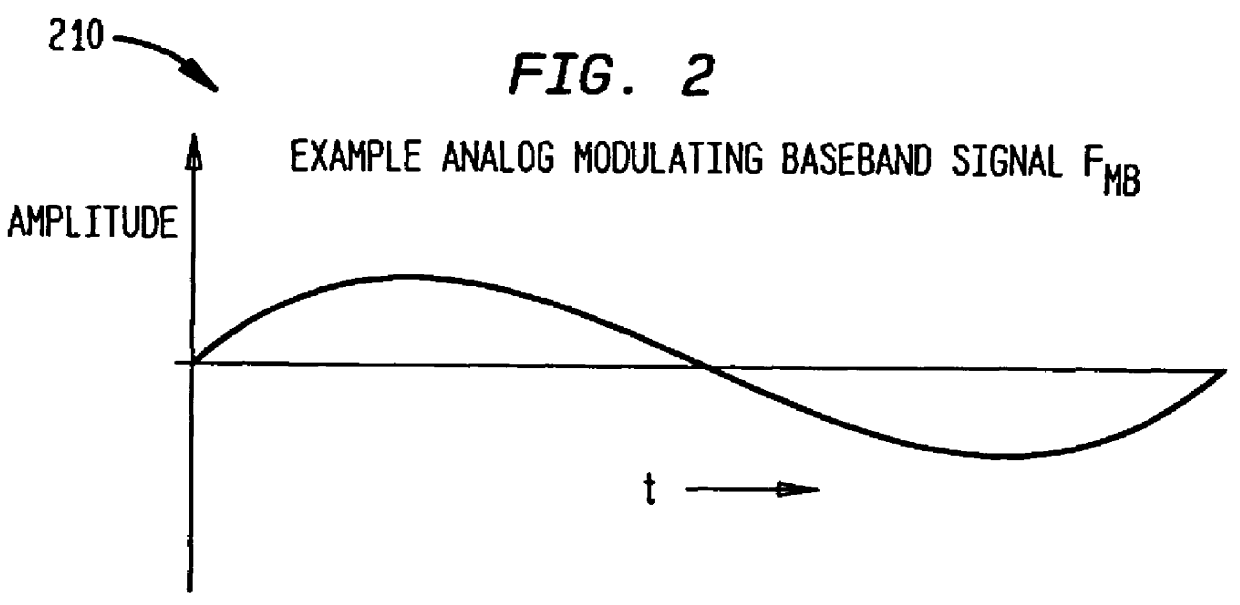Method and system for down-converting electromagnetic signals
a technology of electromagnetic signals and down-converters, applied in the field of down-converters of electromagnetic signals, can solve the problems of limited operation speed of conventional signal processing technology, inability to easily demodulate a baseband signal from a higher frequency modulated carrier signal directly, and inability to work well outside the frequency range of their designed frequency rang
- Summary
- Abstract
- Description
- Claims
- Application Information
AI Technical Summary
Problems solved by technology
Method used
Image
Examples
third example embodiment
1.2.3 Phase Modulation
1.2.3.1 Operational Description
Operation of the exemplary process of the flowchart 4607 in FIG. 46B is described below for the analog PM carrier signal 916, illustrated in FIG. 9C, and for the digital PM carrier signal 1016, illustrated in FIG. 10C.
1.2.3.1.1 Analog PM Carrier Signal
A process for down-converting the analog PM carrier signal 916 in FIG. 9C to an analog PM intermediate signal is now described for the flowchart 4607 in FIG. 46B. The analog PM carrier signal 916 is re-illustrated in FIG. 54A for convenience. For this example, the analog PM carrier signal 916 oscillates at approximately 901 MHZ. In FIG. 54B, an analog PM carrier signal 5404 illustrates a portion of the analog PM carrier signal 916 on an expanded time scale.
The process begins at step 4608, which includes receiving an EM signal. This is represented by the analog PM carrier signal 916.
Step 4610 includes receiving an energy transfer signal having an aliasing rate F.sub.AR. FIG. 54C illu...
first example embodiment
2.2.1 Amplitude Modulation
2.2.1.1 Operational Description
Operation of the exemplary process of the flowchart 4613 in FIG. 46C is described below for the analog AM carrier signal 516, illustrated in FIG. 5C, and for the digital AM carrier signal 616, illustrated in FIG. 6C.
2.2.1.1.1 Analog AM Carrier Signal
A process for directly down-converting the analog AM carrier signal 516 in FIG. 5C to a demodulated baseband signal is now described with reference to the flowchart 4613 in FIG. 46C. The analog AM carrier signal 516 is re-illustrated in 57A for convenience. For this example, the analog AM carrier signal 516 oscillates at approximately 900 MHZ. In FIG. 57B, an analog AM carrier signal portion 5704 illustrates a portion of the analog AM carrier signal 516 on an expanded time scale.
The process begins at step 4614, which includes receiving an EM signal. This is represented by the analog AM carrier signal 516.
Step 4616 includes receiving an energy transfer signal having an aliasing rat...
second example embodiment
2.2.2 Phase Modulation
2.2.2.1 Operational Description
Operation of the exemplary process of flowchart 4613 in FIG. 46C is described below for the analog PM carrier signal 916, illustrated in FIG. 9C and for the digital PM carrier signal 1016, illustrated in FIG. 10C.
2.2.2.1.1 Analog PM Carrier Signal
A process for directly down-converting the analog PM carrier signal 916 to a demodulated baseband signal is now described for the flowchart 4613 in FIG. 46C. The analog PM carrier signal 916 is re-illustrated in 59A for convenience. For this example, the analog PM carrier signal 916 oscillates at approximately 900 MHZ. In FIG. 59B, an analog PM carrier signal portion 5904 illustrates a portion of the analog PM carrier signal 916 on an expanded time scale.
The process begins at step 4614, which includes receiving an EM signal. This is represented by the analog PM carrier signal 916.
Step 4616 includes receiving an energy transfer signal having an aliasing rate F.sub.AR. In FIG. 59C, an exam...
PUM
 Login to View More
Login to View More Abstract
Description
Claims
Application Information
 Login to View More
Login to View More - R&D
- Intellectual Property
- Life Sciences
- Materials
- Tech Scout
- Unparalleled Data Quality
- Higher Quality Content
- 60% Fewer Hallucinations
Browse by: Latest US Patents, China's latest patents, Technical Efficacy Thesaurus, Application Domain, Technology Topic, Popular Technical Reports.
© 2025 PatSnap. All rights reserved.Legal|Privacy policy|Modern Slavery Act Transparency Statement|Sitemap|About US| Contact US: help@patsnap.com



